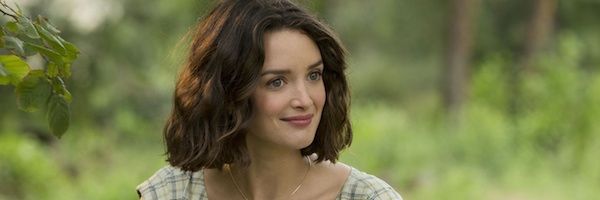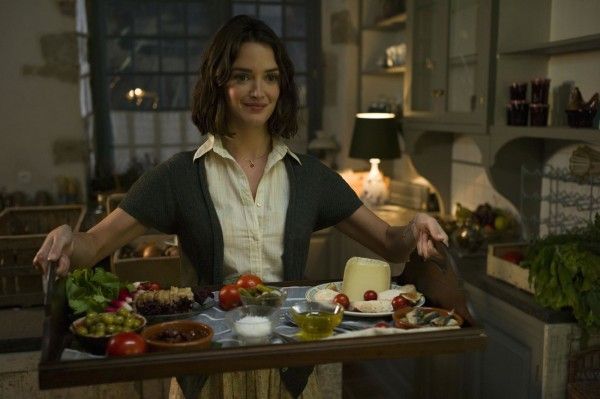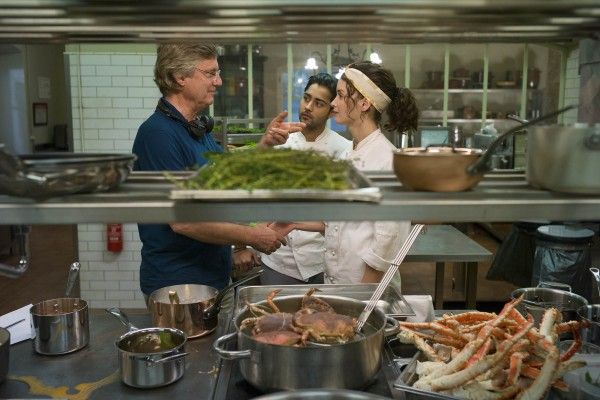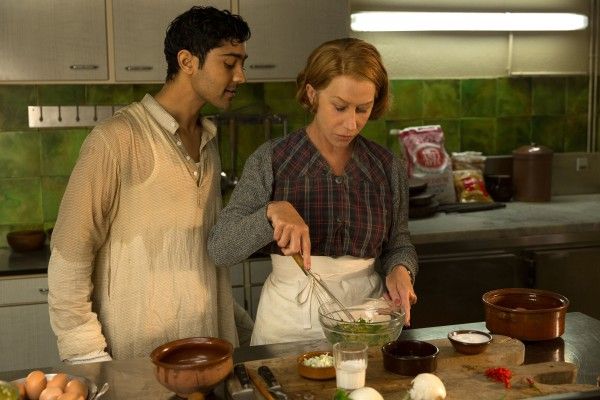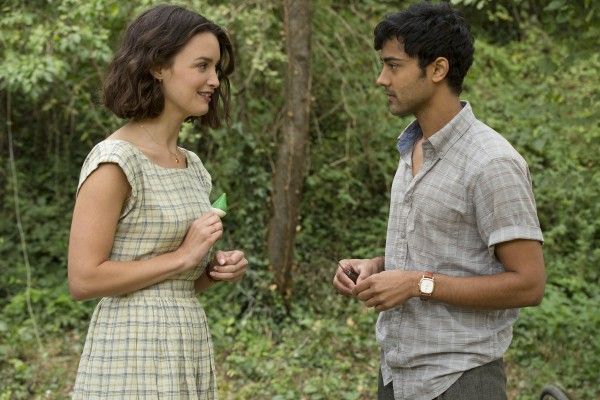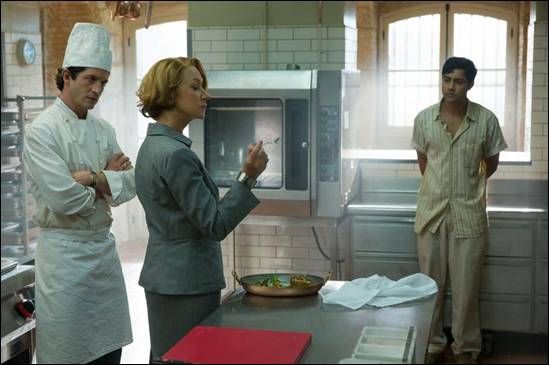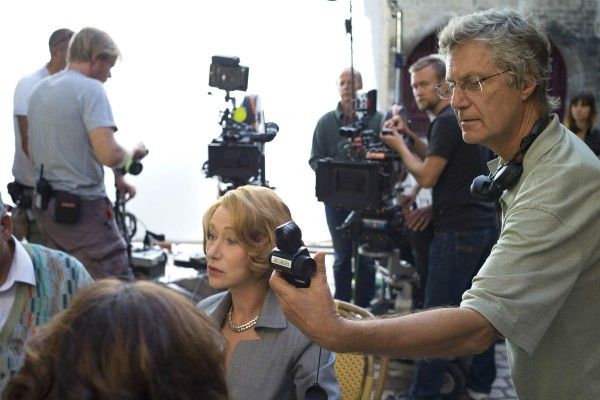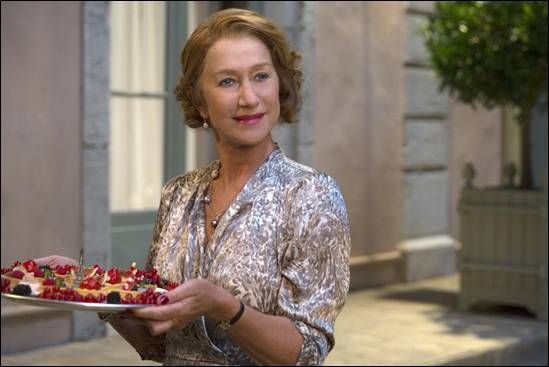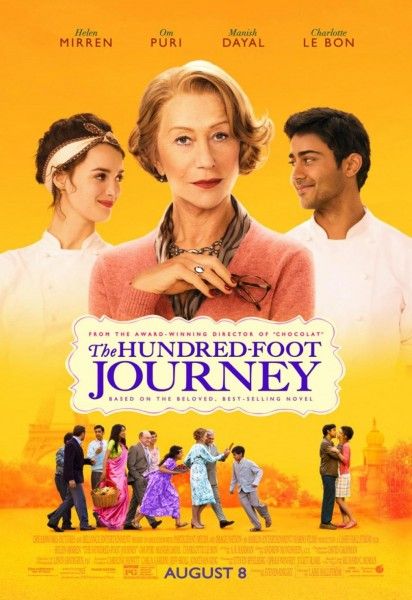Charlotte Le Bon makes her American film debut in The Hundred-Foot Journey as Marguerite, a smart, quick-witted and charming sous chef in the kitchen of Madame Mallory (Helen Mirren), the chilly chef proprietress of Le Saule Pleureur, a Michelin-starred, classical French restaurant in the south of France. Marguerite falls under the spell of Hassan Kadam (Manish Dayal), a culinary ingénue for a colorful new Indian restaurant, Maison Mumbai, which opens directly across the road from her establishment. Hassan weaves culinary magic between their two cultures and invites Marguerite to step out of her comfort zone and cross over into unfamiliar territory. The film, directed by Lasse Hallström also stars Om Puri.
At the film’s recent press day, the Canadian actress spoke about the modeling career that brought her to France, her transition from speaking Québécois French to France French, how she first became involved in the project, her culinary skills, her favorite Québécois food, what she learned working opposite Mirren, her genuine chemistry with Dayal, the perils of food foreplay, how her own life experiences worked their way into the story, the timelessness of the film and her costumes, her favorite movie about food and skyping with producer Steven Spielberg. Hit the jump to check out our Charlotte Le Bon interview for The Hundred-Foot Journey. Disney releases the film on August 8th.
QUESTION: How quickly and how difficult was it for you to go from Québécois French to France French?
CHARLOTTE LE BON: Well, I’ve been living in Paris for five years now, so it kind of did it by itself. After that, when I did the Yves Saint Laurent movie, I had to really drop my Québécois accent because my character wasn’t Québécois for sure. I really worked on that, too. My boyfriend is French, so after that it was easy for me, too. That’s it. It’s just about practice and being easily influenced.
What is the main difference between Québécois and French French?
LE BON: It’s two different cultures. It’s like England and America. In terms of language, I don’t know how to explain it. It’s like different syntax, different words, different expressions, and the musicality is so different. It’s like English from England and English from America.
Can you actually cook or was that all kind of an act?
LE BON: Yes, kind of, I guess.
Do you make your own Hollandaise from scratch?
LE BON: No. It’s not like every time I do a little sauce. I’m alright. I know how to do little things if I want to impress when people come to my place, but I can’t say, “Oh yeah, I’m a cook. Look at me cook.”
What food would you serve someone if you wanted them to understand where you grew up and came from?
LE BON: Oh, I never do that. It could be really bad food. Food from Quebec is not known to be amazing. Actually, even though you can eat really, really well in Montreal, it’s crazy. It’s one of the best cities I eat in, but typical Quebec food is like food from people that work in the woods. It’s potatoes, meat and sauce. So, you don’t want to impress people with that. No. I do something that looks difficult but it’s not really like risotto and stuff like that.
What’s your favorite Québécois food?
LE BON: It’s probably my grandmother’s food. Tourtière. I’m vegetarian, so it’s difficult for me to eat Tourtière. But in the movie, Manish’s character says that food is memories. I don’t even know today if my grandmother’s food is good or not, but for me, it’s one of the best in the world. She just makes super plain meals like soup and desserts. Do you have that Sucre a la Crème? Do you know what it is? It’s like sugar crème, like fudge. It’s like sugar and cream, and you do little cubes, and you put it in your mouth.
Is it like caramels or like the Italian panoche or fudge?
LE BON: Yes, but less cool because it’s not Italian. She does that. I guess that’s my favorite Canadian food.
When you’re making your American film debut and you walk on set and there is Dame Helen Mirren, do you think, “Oh I have to step it up a little bit”?
LE BON: No. I don’t want to do that to myself, because I’ll probably be bad if I say to myself, “I have to step up.” So, I don’t say anything to myself. She’s an amazing woman. That’s for sure. But I’m going to try to do my best. Actually, what was really inspiring working with her is that she owns the place. It’s like she’s there and she’s Helen Mirren. Also, what was great to see is that she’s also struggling sometimes, and she’s asking herself questions, and she’s very generous, too. She’s really, really generous, and she’s asking us questions, like “Do you agree with what I’m proposing?” There was real teamwork with her, even though I just have four scenes with her. But yes, she’s great to work with. I want to be like that when I grow up.
Can you talk a little bit about how you got involved in the project? Was it something that you really went after?
LE BON: No, not at all actually. I did not have a lot of time to do the casting for my first tape. I had to catch a train because I was going somewhere else. I didn’t ask myself too many questions about how the character is because she’s living in a little village and she’s French. I just did it and that’s it. After that, I just completely forgot about it. I was also saying to myself, “Well it’s Spielberg. It will never work anyway because they’re seeing thousands of girls.” One week later, they called me back to do another one, and I didn’t know it was going to be with Manish and Lasse, so I said, “Oh, that’s getting official. Okay.” We just had fun. I got along very, very quickly with Manish, and that helped me a lot, too. That’s it.
You and Mr. Dayal have this very real chemistry. You can fake it.
LE BON: You can fake it.
But it doesn’t feel like you were. Was that one of the pleasures of the film, finding out that you and Mr. Dayal had this very easy interplay that could be about warmth and coldness and different emotions, but always had a very real energy to it?
LE BON: We got along super, super quick and very well, and we became super close friends. For sure it helps, because you’re not shy to ask questions and propose stuff and say, “I don’t understand what you’re doing. Maybe we should do it this way. What do you think about that?” It was real teamwork, and teamwork is always the best when you agree. It’s also a big thing for both of us. I just did this movie with Joseph Gordon-Levitt on the last Zemeckis movie (To Reach the Clouds), and we don’t share the same vision of work. That’s for sure. He’s done thousands of movies. But for Manish and me, it was our first official American movie, so we were in the same kind of mental space.
Was there a day that you remember when you were both struggling with something? Was there a scene that you both worked together on?
LE BON: Yes actually. There is this scene when we’re in the woods, and he scares me because he’s picking mushrooms. That’s when we kiss for the first time in the woods. Lasse changed the scene in the morning. He changed all the dialogue. Lasse is Swedish, so even with English dialogue sometimes he says things that don’t really work. It’s normal because he’s Swedish. He wrote this long scene about mushrooms, and I was calling the mushroom “the chubby little thing.” I don’t know if you see where I’m going, but it was like, “Oh my God! Oh those chubby little things. I love to eat them. They’re amazing. Mmm, ooh, ah. You can eat those raw. You know that, right?” And then I take a bite of the chubby little mushroom when I’m looking at Manish in the eyes, and we were like, “Lasse, we cannot do this. You won’t get your PG rating with this scene. It’s just impossible."
So the food foreplay went too far?
LE BON: Yes, exactly. And so, to prove to him that he was wrong, we filmed each other, Manish and I, in his trailer with the dialogue, and we showed it to him, and he said, “Oh yeah, you’re right. We won’t do it.”
Was there something about not being American but working in an American film, working in the film industry, traveling a lot, and doing what you do that gave you the bigger picture of the story? Does your own life experience work its way into something like this?
LE BON: Maybe it helped me in the way that Marguerite is. I see her as a leader because she knows exactly what she wants and nobody can take her place. Well, kind of. (Laughs) I really liked that about her. It’s unfortunate, but sometimes feminine characters can only be the girlfriend and that’s it. They don’t have so much to their role. That’s why I really liked the scene when he says he’s going to enter the kitchen and she’s like, “Oh, okay,” and she’s getting passive aggressive. I like that about her. She’s not getting stepped on. I guess I learned that through my own journey. I don’t know if it makes sense, but I decided to quit Montreal five years ago to come to France, even though I didn’t know what was waiting for me at that time. I was just modeling, and I was really unhappy and super, super sad. I hated that job, but something was just telling me to go, and even though I was just trying, I didn’t want to take the plane and leave my family and friends. I was like, “What am I doing to my life?” And then, I arrived in Paris, and two years after that, I started to do that TV show and everything went for me. So yes, it’s just to trust yourself as your own leader in your own life.
I’m very curious about your look in the film and the clothing you’re wearing. How much are you collaborating with people to come up with that and how much of it is being told to you, “Hey, you’re going to wear this and you’re going to wear that”?
LE BON: I think the only input you can have in costumes is like, “I hate myself in that.” That’s it. “I think I look bad” or “I think I look fat.” That’s probably the only input you can have for costumes.
So basically, it’s pretty much they hand you something and you say, “Sure.”
LE BON: Exactly.
The dresses were beautiful.
LE BON: I still don’t know, and the story is taking part in the village, and you don’t really know in which era it is. Is it in the 80’s or 90’s or is it now, because she’s wearing those kinds of dresses?
The costumes seem to transform time.
LE BON: I know. Now Manish is in Paris and we’re in 2013.
Everybody is on cell phones but also dresses a little bit like they’re studying with Julia Child in the 1970s and 1980s with all the crisp white linen.
LE BON: Exactly. I liked that about the movie. It’s just that you cannot really situate it.
There’s a great subgenre of movies about food like Big Night, Tampopo, and even that great scene in Tom Jones. What’s your favorite movie about food?
LE BON: About food? Do I have one? I’m not saying this because we’re in promotion, but the first food movie that I really liked was Chocolat. I don’t know if you know this, but Lasse Hallstrom is a vegan. I think that’s why he’s able to film food that way because he’s probably so frustrated with food. In Chocolat, too, he’s so sensual in the way he films food, and I think that’s probably one of the most important reasons.
Do you think he’s like, “I can’t touch this steak, but I’m going to film the heck out of it. I’m going to make it look beautiful even though I can’t have it.”?
LE BON: “I’m going to film the hell out of it!” Yes! That’s exactly what he’s doing and it works.
Did you get to meet Steven Spielberg at all?
LE BON: On Skype. I think it’s almost cooler to say that. I did Skype with Steven Spielberg.
What was that like? Was it after you got cast?
LE BON: It was after we shot the movie. Actually, it was last April. I went to DreamWorks here to meet with the casting agent. There was just this big table there with a big screen, and I said, “Oh, are we waiting for somebody?,” and she said, “Oh yes, Steven’s coming.” I said, “Okay, very well.” So, I sat there and he arrived, and he was on his yacht, and he was Skyping with me. He’s really nice. He’s this very accessible, cool human being.
He was Skyping to you from a yacht like a James Bond villain?
LE BON: Yes, exactly like a James Bond villain.
When you got that [first acting] job, did they say to you, “This is what you’re going to be doing every day”?
LE BON: No, actually they didn’t know I was going to go that far, because usually the girl that was doing my job was just putting on beautiful dresses and saying two or three jokes and giving the weather. But after two weeks of that, I was getting really bored, so I started to go deeper and deeper, and people liked that. So, the producer just said, “Go ahead.”
Is comedy your forte? Is that the area you prefer to work in?
LE BON: I have no preferences. I like to make people laugh. That’s for sure. And I really like to humiliate myself and go very far in derision and stuff. But no, I like everything. I started a little bit of doing drama, too. I like that, too. I guess I just want to touch everything.
Was there any sketch that you did that they were like, “No!” Did you have to get clearance on these sketches or did you just do it?
LE BON: I did really, really bad sketches that the public was saying, “No.” I was giving everything I had, and there was nothing going, and you just heard flies (she makes a buzzing sound).
Was there a live audience?
LE BON: Yes, there was an audience and it was on live TV as well.
Was it hard for you to come up with that every day and to try to find really funny stuff?
LE BON: Yes, and it wasn’t always really funny. That’s why.
That sounds like a great learning experience. Do you feel like it helped you?
LE BON: Yes, because it’s so good for the ego. It’s a daily show, so even if I was doing a really bad sketch one day, I knew that the day after that I was going to try to do something else, and you don’t die from being ridiculous. I really know that. So, it helped me a lot.
What do you hope people will take from this film?
LE BON: Everyone is going to get their own thing from it. It’s about so many different things. It’s about different cultures, and that when you agree to meet with them, you get stronger. I really think that is true. It’s about passion. It’s about traveling. It’s about a character that just goes for it, even though everybody else is telling him it’s impossible. It’s about love. It’s about going back to your roots, too. So yes, an audience is going to take whatever they want.

